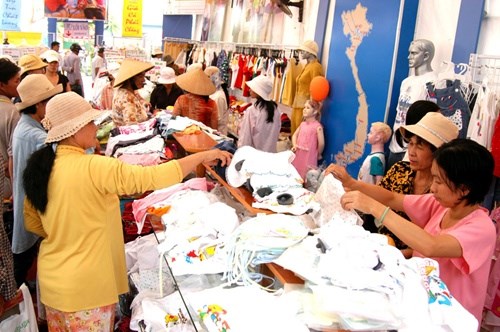Firms urged to sell Vietnam’s products in rural areas
The role of firms remained critical in expanding points of sales and building a solid distribution foothold in rural markets where local residents had a thirst for locally-produced goods.
 Consumers shop at a market selling Vietnamese products in northern Ha Nam Province. (Photo: hanam.gov.vn)
Consumers shop at a market selling Vietnamese products in northern Ha Nam Province. (Photo: hanam.gov.vn)Hanoi (VNA) – The role of firms remained critical in expanding points of sales and building a solid distribution foothold in rural markets where local residents had a thirst for locally-produced goods, according to the Ministry of Industry and Trade (MoIT).
While bringing Vietnamese products to rural areas was a major programme in the campaign “Vietnamese give priority to using Vietnamese goods”, the ministry said the organisation of sales were not regular, making it difficult for consumers in rural areas to buy made-in-Vietnam products. So, the efficiency of the programme was below expectation.
Firms still did not attach large significance to rural markets due to the weaker purchasing power in these areas coupled with a shortage of capital to develop the distribution system.
As price was a major concern of consumers in rural areas, Vietnamese products faced severe competition from cheaper products of unclear origins that remained rampant in rural areas, a representative from retailer Hapro said.
Hapro said that purchasing power was still low and its revenues from bringing Vietnamese products to rural areas last year dropped by around 20 percent compared to the previous year.
Experts also said that it would take time to increase the awareness of consumers in rural areas about benefits of using made-in-Vietnam products and to form a habit of using locally produced goods.
Policies to encourage firms to develop retail channels in rural areas were needed, experts said, adding that firms should pay more attention to rural, mountainous and remote markets as this would not only promote the distribution of their products but also create jobs for local labourers.
Chairman of the Hanoi Supermarket Association Vu Vinh Phu said firms should join hands with local traders to put their goods on shelves at traditional markets or groceries. “Connecting with local traders will be a good idea for firms to expand their point-of-sale system in rural areas, especially remote areas where access to Vietnamese quality products remained limited.”
MoIT’s statistics revealed that there were more than 9,000 traditional markets in Vietnam which distributed some 80 percent of goods to local consumers, making traditional markets a useful retail channel to distribute Vietnamese products.
MoIT Deputy Minister Do Thang Hai said that efforts in fighting smuggled and counterfeit products must also be strengthened to pave the way for promoting the consumption of Vietnamese products.
According to the Steering Committee of the “Vietnamese give priority to using Vietnamese goods” campaign, more than 2,200 sales were organised in rural areas during the past six years.-VNA













